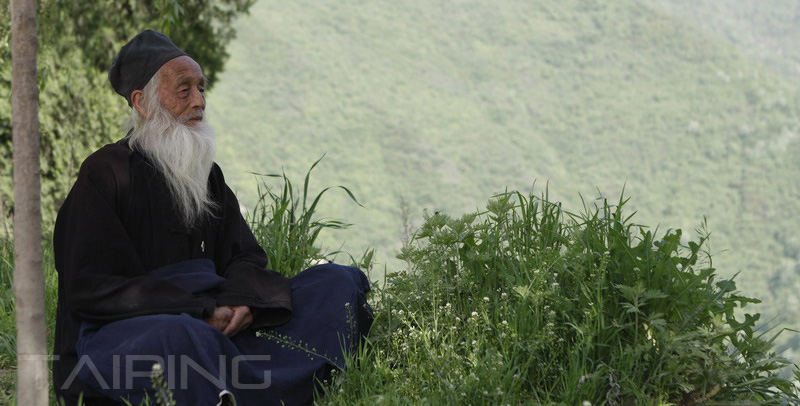
老子 (Laozi) and his book 道德经 (Daode Jing) are traditionally dated to the 6th century BCE. However scholars' datings for the book range from the 8th century BCE to the 3rd century BCE. In comparison, the date ascribed to Buddha ranges from the 6th to the 4th centuries BCE while 孔子 (Kongzi or Confucius) can be more accurately dated as having lived from 551 to 479 BCE. Following Laozi, 莊子 (Zhuangzi or Chuang Tzu), the second important Taoist author, lived from 369 to 286 BCE.
However, the founding of Taoism as a religion (道教 or Daojiao) is traditionally ascribed to 张道陵 (Zhang Daoling) and his 正一盟威 (Zhengyi Mengwei). At the end of the 汉朝 (Han Chao or Han Dynasty), 张陵 (Zhang Ling) settled on 鹤鸣山 (Heming Shan or Crane's Cry Mountain) in what is today's 四川 (Sichuan) and started teaching there. The Taoist school that arose from his teachings is called 正一道 (Zhengyi Dao) after his teachings. It is also variously known as 天师道 (Tianshi Dao or Celestial Masters Taoism) or 五斗米道 (Wudoumi Dao or Five Pecks of Rice Taoism). After the passing of 张道陵, his son, 张衡 (Zhang Heng), then his grandson, 张鲁 (Zhang Lu), led the sect. It was 张鲁 (Zhang Lu), who submitted to 曹操 (Caocao or Tsao Tsao) in 215CE.
At the same as the Zhang Ling started the Tianshi Dao in the West of China (Sichuan area), In the East or Central plains of China, 张角 (Zhang Jue) founded the 太平道 (Taiping Dao) which led to establish one of the first peasant uprisings/rebellion, known as 黄巾起义 (Huangbu qiyi or Yellow Turban Uprising) rebellion started in 184CE
The Three Schools (Shangqing, Lingbao, Sanhuang)
For the origins of the 上清茅山 (Shangqing Maoshan) school, we have to go back to 362CE when the wife of 许谧 (Xu Mi), 陶可斗 (Tao Kedou), passed away. The 许 (Xu) brothers hired a medium, 杨羲 (Yang Xi), to contact 陶可斗. The spirit that came described among other things, the highest heaven 上清 (Shangqing) and 华陽(Huayang) Grotto on 茅山 (Maoshan). However, the written record of the brothers was scattered until a descendent of 陶可斗 (Tao Kedou), 陶弘景 (Tao Hongjing), recompiled them into 真诰 (Zhengao or Declarations of the Perfected). It is therefore 陶弘景 (456-536CE) who founded the 上清 (Shangqing) school which became the dominant Taoist school during the 隋朝 (Sui Chao or Sui Dynasty, 581-618CE).
In the 390s, a Shangqing practioner, 葛巢甫 (Ge Chaofu) founded the 灵宝 (Lingbao) school. Among the developments of that school was the idea of a central creator god, 元始天尊 (Yuanshi Tianzun or Heavenly Worthy of Primordial Beginnings). In this formulation, Laozi became 太尚道君 (Taishan Daojun or Lord of Dao). Besides the Shangqing and Lingbao schools, there was also a 三皇 (Sanhuang) school which became defunct by the 7th century.
陆修静 (Lu Xiujing) divided Taoist knowledge into three based on the three major schools:
1) 洞真 (Dongzhen) ► 上清 (Shangqing) ► 元始天尊 (Yuanshi Tianzun or Heavenly Worthy of Primordial Beginnings)
2) 洞玄 (Dongxuan) ► 灵宝 (Lingbao) ► 太尚道君 (Taishan Daojun or Lord of Dao)
3) 洞神 (Dongshen) ► 三皇 (Sanhuang) ► 老君 (Laojun or Lord Lao)
Northern & Southern Celestial Master Schools
The first time Taoism became a state religion was when 寇谦之 (Kou Qianzhi) (365-448CE) brought his relevations to the Toba court in 424CE (北朝北魏). Kou reformed Celestial Masters Taoism (正一道) based on the relevations he had received at 松山 (Songshan).
A century later, Lu Xiujing (陆修静) also reformed Taoist practices during the 南朝宋. Lu Xiujing's (406-477CE) school of reform became known as the Southern Celestial Master school while the earlier reformation by Kou became the Northern Celestial Master school.
Louguan Dao
This school was started by 尹通 (Yin Tong) who is said to have received the 道 (Dao) in 424CE. Yin Tong is said to be a descendent of 尹喜 (Yin Xi), the official who met Laozi at 函谷 (Hangu) Pass in 河南 (Henan). Yin Xi is said to have brought Laozi to his tower, 楼观台 (Louguan Tai), on 终南山 (Zhongnan Shan) in 陕西 (Shaanxi). Louguan Tai became the first established Taoist monastry and during the Tang Dynasty, it was bestowed the imperial name of 宗圣观 (Zongsheng Guan or Monastry of the Ancestral Sage). The school's height was during the 隋 (Sui) & 唐 (Tang) dynasties.
Song Schools
This is the period when the most important 内丹 (neidan or Inner Alchemy) school developed: the 南宗 (Nanzong) school. Inner Alchemy is reputed to have been founded by the immortals 钟离权 (Zhong Liquan) & 吕洞宾 (Lü Dongbin). Zongdong Inner Alchemy is most closely identified with Nanzong Inner Alchemy.
The Southern Song period was dominated by the 龙虎山 (Longhu Shan) school in 江西 (Jiangxi). The Longhu Shan school is of the 灵宝 (Lingbao) tradition. Also influential then were the 茅山 (Maoshan) and 阁皂山 (Gezao Shan) schools. Like Longhu Shan, Gezao Shan is a Lingbao affiliate based in Jiangxi.
Jin Schools (1115-1234CE)
During the 金 (Jin), the main traditions were 太一 (Taiyi or Supreme Oneness), 大道 (Dadao or Great Tao), & 全真 (Quanzhen or Complete Perfection). However, both Taiyi & Dadao were absorbed by 正一 (Zhenyi) by the end of the 元 (Yuan).
全真道 (Quanzhen Dao) was founded by 王重陽 (Wang Chongyang). Wang (1112-1170CE) had retired to 终南山 (Zhongnan Shan) in 1159CE but then moved to 山东 (Shandong) in 1167CE to teach. Of his seven disciples 七真 (qizhen), the most important was 长春 (Chang Chun) aka 邱处机 (Qiu Chuji) who founded the 龙门 (Longmen) branch of the Quanzhen in 陕西 (Shaanxi). Chang Chun (1148-1227CE) was summoned to meet Chinggis Khan in 1219CE. The account of Chang Chun's journey was recorded as 西游记 (Xiyou Ji or Travels of an Alchemist) by his disciple and successor, 李志常 (Li Zhichang).
During the 元 (Yuan), the Zhenyi & Quanzhen schools became dominant and both have retained their importance till today.